INT103 Human Development Across Lifespan: Community Service Report
VerifiedAdded on 2022/11/09
|8
|1818
|312
Report
AI Summary
This report undertakes a comparative analysis of Erikson's Psychosocial theory and Maslow's Hierarchy of Needs to understand childhood development. The report begins with an abstract summarizing the core concepts, followed by an introduction which discusses the importance of understanding childhood development and the significance of the two chosen theories. The discussion section delves into Erikson's stages of psychosocial development, focusing on the infancy stage, and correlates it with Maslow's hierarchy of needs, highlighting the commonalities between the two theories. The conclusion synthesizes the key findings, emphasizing the importance of needs fulfillment in early stages of life and the impact on future development. The report also includes reflections and recommendations, discussing the analytical skills demonstrated and areas for improvement, followed by a list of cited references. Overall, the report provides a comprehensive overview of how the theories of Erikson and Maslow can be used to understand childhood development. The report also provides justification for the understanding of the development of certain behaviors and actions based on how well the primary needs whose fulfillment determines how well the progression to the next level will be.
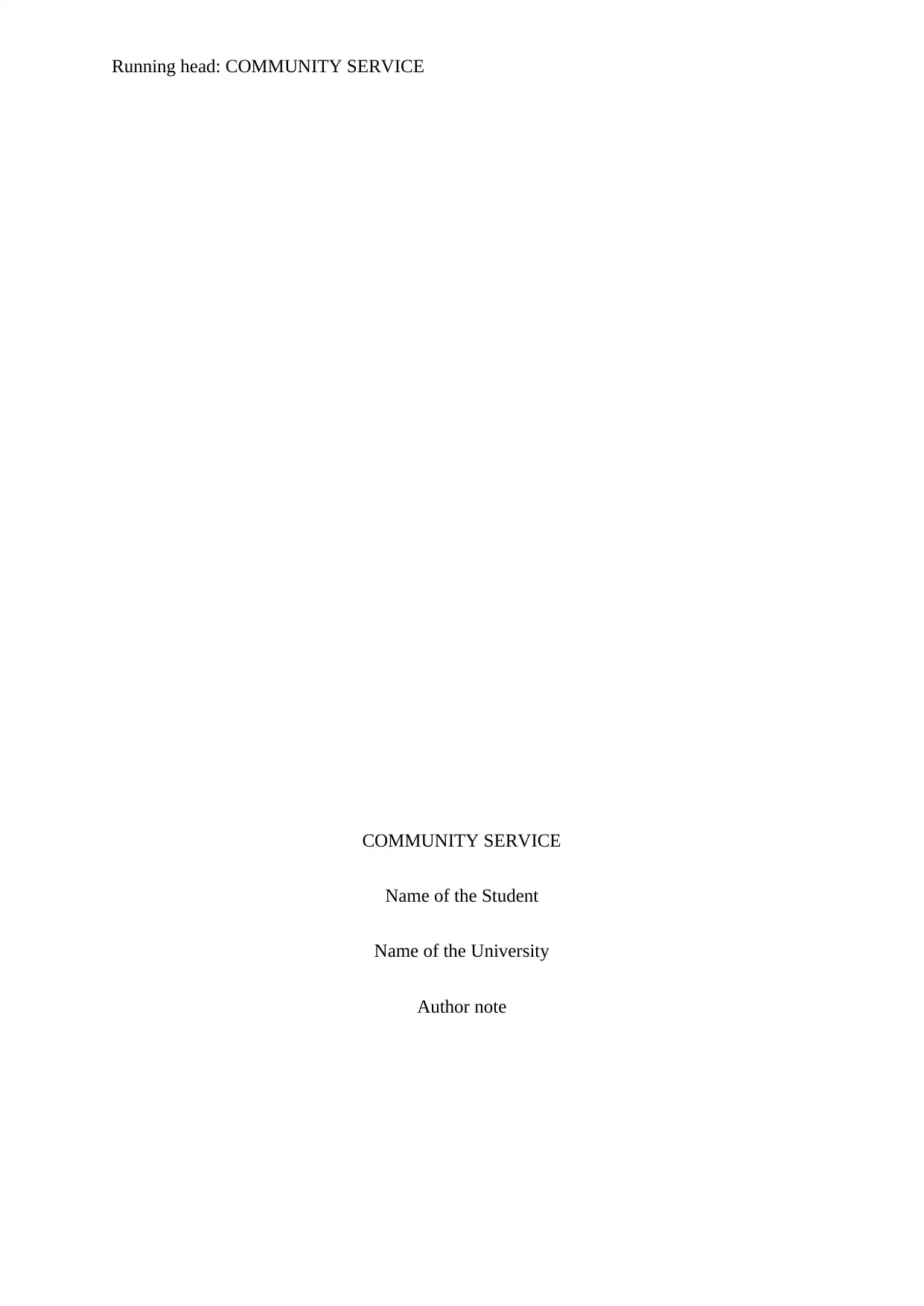
Running head: COMMUNITY SERVICE
COMMUNITY SERVICE
Name of the Student
Name of the University
Author note
COMMUNITY SERVICE
Name of the Student
Name of the University
Author note
Paraphrase This Document
Need a fresh take? Get an instant paraphrase of this document with our AI Paraphraser
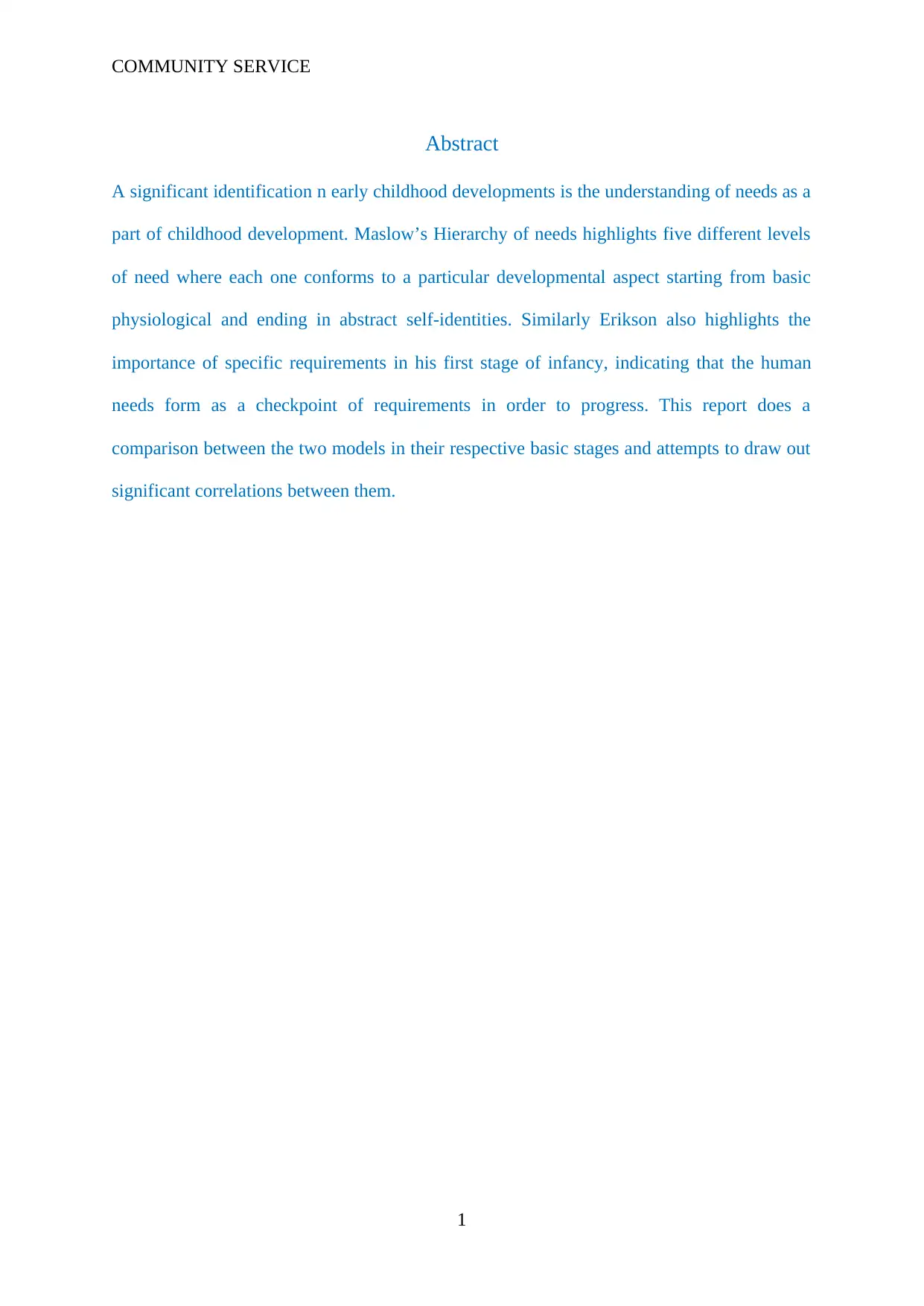
COMMUNITY SERVICE
Abstract
A significant identification n early childhood developments is the understanding of needs as a
part of childhood development. Maslow’s Hierarchy of needs highlights five different levels
of need where each one conforms to a particular developmental aspect starting from basic
physiological and ending in abstract self-identities. Similarly Erikson also highlights the
importance of specific requirements in his first stage of infancy, indicating that the human
needs form as a checkpoint of requirements in order to progress. This report does a
comparison between the two models in their respective basic stages and attempts to draw out
significant correlations between them.
1
Abstract
A significant identification n early childhood developments is the understanding of needs as a
part of childhood development. Maslow’s Hierarchy of needs highlights five different levels
of need where each one conforms to a particular developmental aspect starting from basic
physiological and ending in abstract self-identities. Similarly Erikson also highlights the
importance of specific requirements in his first stage of infancy, indicating that the human
needs form as a checkpoint of requirements in order to progress. This report does a
comparison between the two models in their respective basic stages and attempts to draw out
significant correlations between them.
1
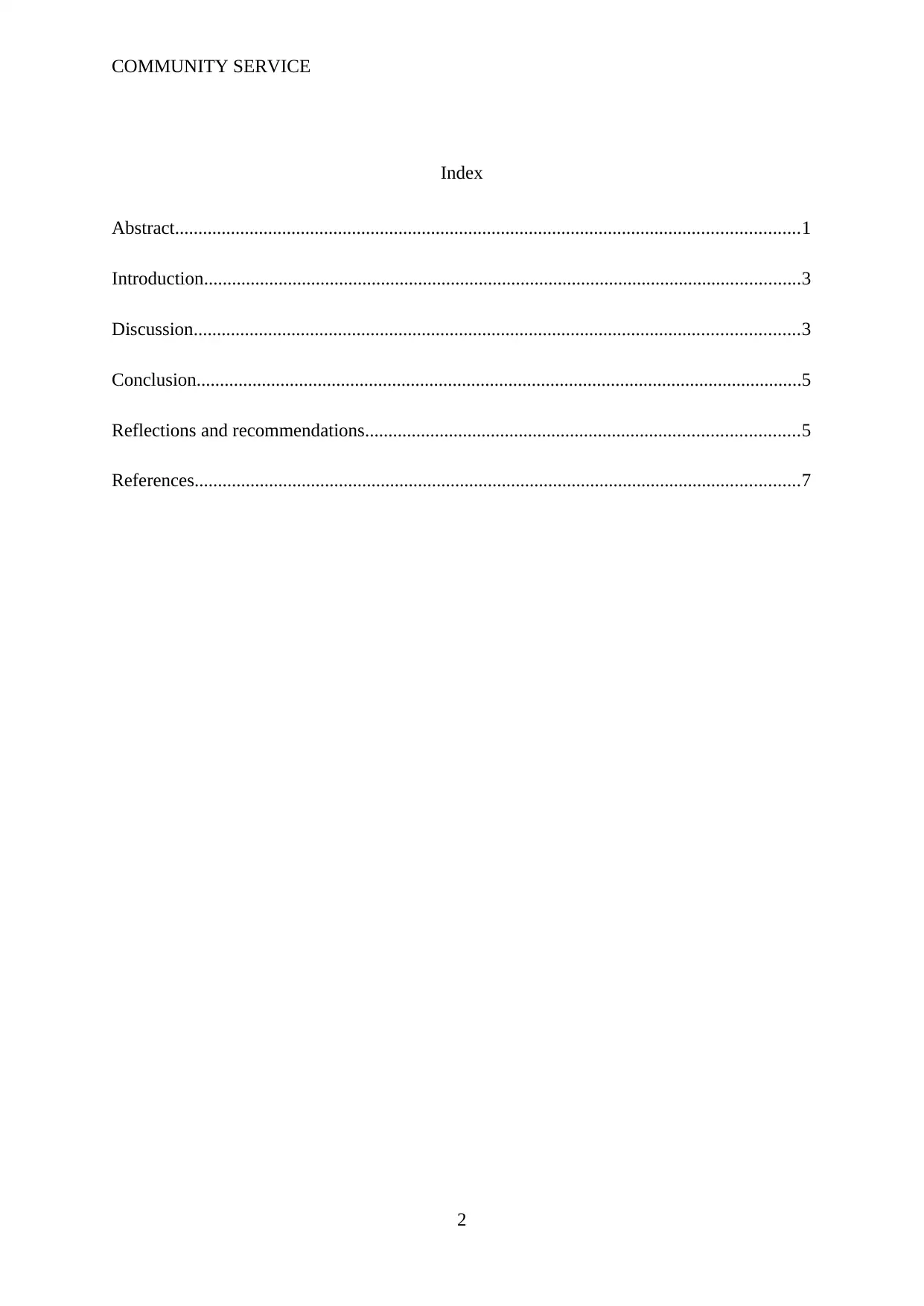
COMMUNITY SERVICE
Index
Abstract......................................................................................................................................1
Introduction................................................................................................................................3
Discussion..................................................................................................................................3
Conclusion..................................................................................................................................5
Reflections and recommendations.............................................................................................5
References..................................................................................................................................7
2
Index
Abstract......................................................................................................................................1
Introduction................................................................................................................................3
Discussion..................................................................................................................................3
Conclusion..................................................................................................................................5
Reflections and recommendations.............................................................................................5
References..................................................................................................................................7
2
⊘ This is a preview!⊘
Do you want full access?
Subscribe today to unlock all pages.

Trusted by 1+ million students worldwide
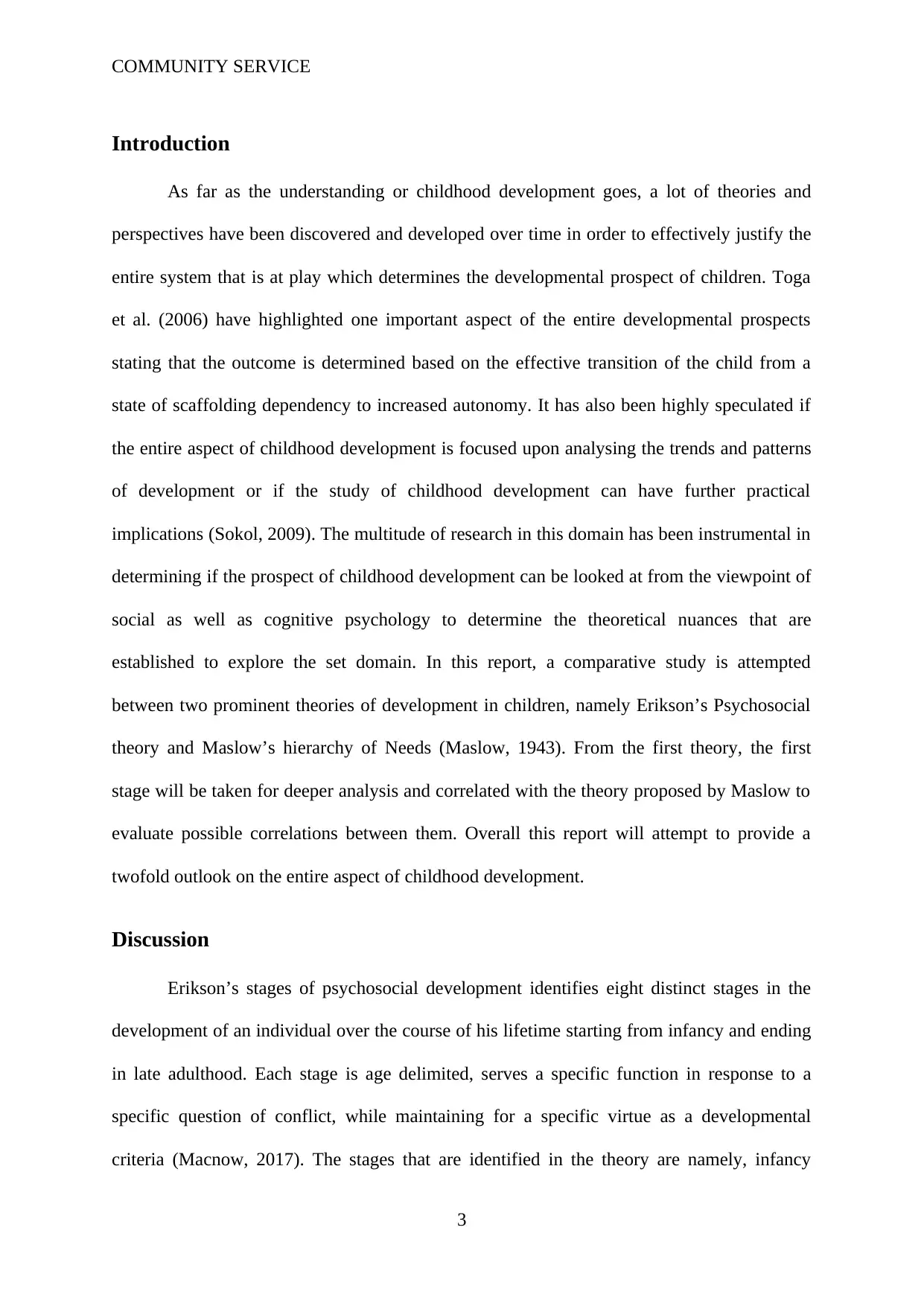
COMMUNITY SERVICE
Introduction
As far as the understanding or childhood development goes, a lot of theories and
perspectives have been discovered and developed over time in order to effectively justify the
entire system that is at play which determines the developmental prospect of children. Toga
et al. (2006) have highlighted one important aspect of the entire developmental prospects
stating that the outcome is determined based on the effective transition of the child from a
state of scaffolding dependency to increased autonomy. It has also been highly speculated if
the entire aspect of childhood development is focused upon analysing the trends and patterns
of development or if the study of childhood development can have further practical
implications (Sokol, 2009). The multitude of research in this domain has been instrumental in
determining if the prospect of childhood development can be looked at from the viewpoint of
social as well as cognitive psychology to determine the theoretical nuances that are
established to explore the set domain. In this report, a comparative study is attempted
between two prominent theories of development in children, namely Erikson’s Psychosocial
theory and Maslow’s hierarchy of Needs (Maslow, 1943). From the first theory, the first
stage will be taken for deeper analysis and correlated with the theory proposed by Maslow to
evaluate possible correlations between them. Overall this report will attempt to provide a
twofold outlook on the entire aspect of childhood development.
Discussion
Erikson’s stages of psychosocial development identifies eight distinct stages in the
development of an individual over the course of his lifetime starting from infancy and ending
in late adulthood. Each stage is age delimited, serves a specific function in response to a
specific question of conflict, while maintaining for a specific virtue as a developmental
criteria (Macnow, 2017). The stages that are identified in the theory are namely, infancy
3
Introduction
As far as the understanding or childhood development goes, a lot of theories and
perspectives have been discovered and developed over time in order to effectively justify the
entire system that is at play which determines the developmental prospect of children. Toga
et al. (2006) have highlighted one important aspect of the entire developmental prospects
stating that the outcome is determined based on the effective transition of the child from a
state of scaffolding dependency to increased autonomy. It has also been highly speculated if
the entire aspect of childhood development is focused upon analysing the trends and patterns
of development or if the study of childhood development can have further practical
implications (Sokol, 2009). The multitude of research in this domain has been instrumental in
determining if the prospect of childhood development can be looked at from the viewpoint of
social as well as cognitive psychology to determine the theoretical nuances that are
established to explore the set domain. In this report, a comparative study is attempted
between two prominent theories of development in children, namely Erikson’s Psychosocial
theory and Maslow’s hierarchy of Needs (Maslow, 1943). From the first theory, the first
stage will be taken for deeper analysis and correlated with the theory proposed by Maslow to
evaluate possible correlations between them. Overall this report will attempt to provide a
twofold outlook on the entire aspect of childhood development.
Discussion
Erikson’s stages of psychosocial development identifies eight distinct stages in the
development of an individual over the course of his lifetime starting from infancy and ending
in late adulthood. Each stage is age delimited, serves a specific function in response to a
specific question of conflict, while maintaining for a specific virtue as a developmental
criteria (Macnow, 2017). The stages that are identified in the theory are namely, infancy
3
Paraphrase This Document
Need a fresh take? Get an instant paraphrase of this document with our AI Paraphraser
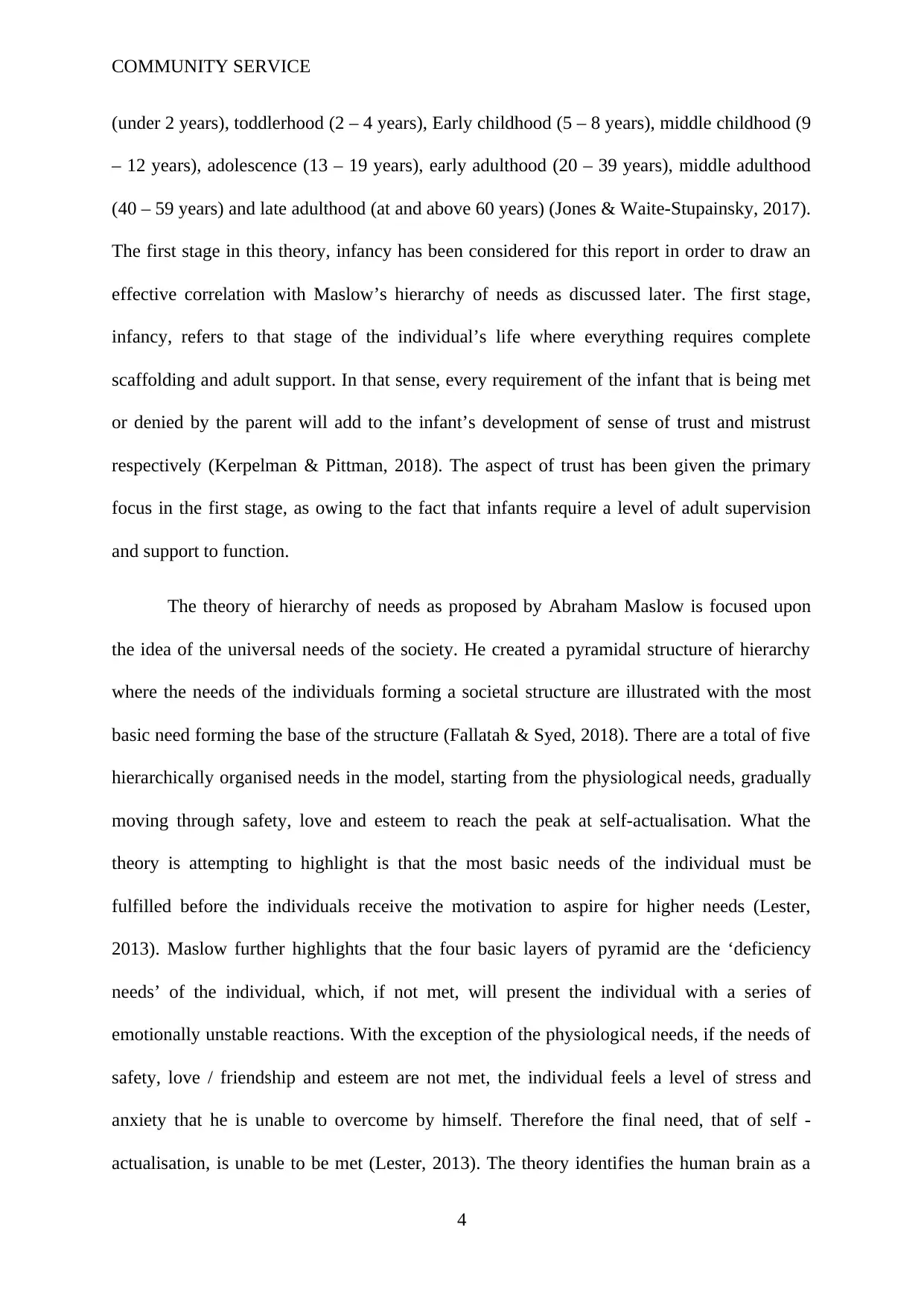
COMMUNITY SERVICE
(under 2 years), toddlerhood (2 – 4 years), Early childhood (5 – 8 years), middle childhood (9
– 12 years), adolescence (13 – 19 years), early adulthood (20 – 39 years), middle adulthood
(40 – 59 years) and late adulthood (at and above 60 years) (Jones & Waite-Stupainsky, 2017).
The first stage in this theory, infancy has been considered for this report in order to draw an
effective correlation with Maslow’s hierarchy of needs as discussed later. The first stage,
infancy, refers to that stage of the individual’s life where everything requires complete
scaffolding and adult support. In that sense, every requirement of the infant that is being met
or denied by the parent will add to the infant’s development of sense of trust and mistrust
respectively (Kerpelman & Pittman, 2018). The aspect of trust has been given the primary
focus in the first stage, as owing to the fact that infants require a level of adult supervision
and support to function.
The theory of hierarchy of needs as proposed by Abraham Maslow is focused upon
the idea of the universal needs of the society. He created a pyramidal structure of hierarchy
where the needs of the individuals forming a societal structure are illustrated with the most
basic need forming the base of the structure (Fallatah & Syed, 2018). There are a total of five
hierarchically organised needs in the model, starting from the physiological needs, gradually
moving through safety, love and esteem to reach the peak at self-actualisation. What the
theory is attempting to highlight is that the most basic needs of the individual must be
fulfilled before the individuals receive the motivation to aspire for higher needs (Lester,
2013). Maslow further highlights that the four basic layers of pyramid are the ‘deficiency
needs’ of the individual, which, if not met, will present the individual with a series of
emotionally unstable reactions. With the exception of the physiological needs, if the needs of
safety, love / friendship and esteem are not met, the individual feels a level of stress and
anxiety that he is unable to overcome by himself. Therefore the final need, that of self -
actualisation, is unable to be met (Lester, 2013). The theory identifies the human brain as a
4
(under 2 years), toddlerhood (2 – 4 years), Early childhood (5 – 8 years), middle childhood (9
– 12 years), adolescence (13 – 19 years), early adulthood (20 – 39 years), middle adulthood
(40 – 59 years) and late adulthood (at and above 60 years) (Jones & Waite-Stupainsky, 2017).
The first stage in this theory, infancy has been considered for this report in order to draw an
effective correlation with Maslow’s hierarchy of needs as discussed later. The first stage,
infancy, refers to that stage of the individual’s life where everything requires complete
scaffolding and adult support. In that sense, every requirement of the infant that is being met
or denied by the parent will add to the infant’s development of sense of trust and mistrust
respectively (Kerpelman & Pittman, 2018). The aspect of trust has been given the primary
focus in the first stage, as owing to the fact that infants require a level of adult supervision
and support to function.
The theory of hierarchy of needs as proposed by Abraham Maslow is focused upon
the idea of the universal needs of the society. He created a pyramidal structure of hierarchy
where the needs of the individuals forming a societal structure are illustrated with the most
basic need forming the base of the structure (Fallatah & Syed, 2018). There are a total of five
hierarchically organised needs in the model, starting from the physiological needs, gradually
moving through safety, love and esteem to reach the peak at self-actualisation. What the
theory is attempting to highlight is that the most basic needs of the individual must be
fulfilled before the individuals receive the motivation to aspire for higher needs (Lester,
2013). Maslow further highlights that the four basic layers of pyramid are the ‘deficiency
needs’ of the individual, which, if not met, will present the individual with a series of
emotionally unstable reactions. With the exception of the physiological needs, if the needs of
safety, love / friendship and esteem are not met, the individual feels a level of stress and
anxiety that he is unable to overcome by himself. Therefore the final need, that of self -
actualisation, is unable to be met (Lester, 2013). The theory identifies the human brain as a
4
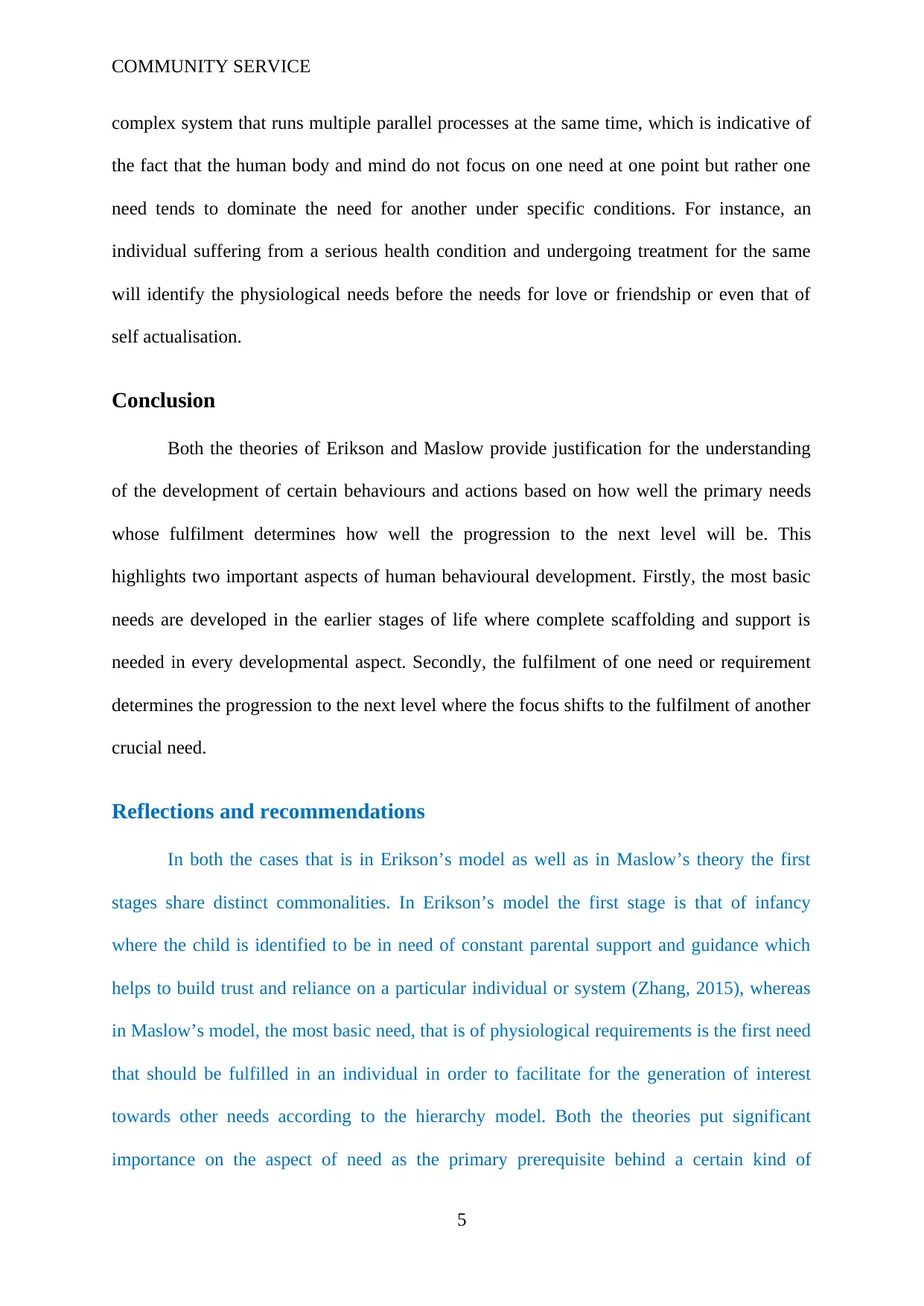
COMMUNITY SERVICE
complex system that runs multiple parallel processes at the same time, which is indicative of
the fact that the human body and mind do not focus on one need at one point but rather one
need tends to dominate the need for another under specific conditions. For instance, an
individual suffering from a serious health condition and undergoing treatment for the same
will identify the physiological needs before the needs for love or friendship or even that of
self actualisation.
Conclusion
Both the theories of Erikson and Maslow provide justification for the understanding
of the development of certain behaviours and actions based on how well the primary needs
whose fulfilment determines how well the progression to the next level will be. This
highlights two important aspects of human behavioural development. Firstly, the most basic
needs are developed in the earlier stages of life where complete scaffolding and support is
needed in every developmental aspect. Secondly, the fulfilment of one need or requirement
determines the progression to the next level where the focus shifts to the fulfilment of another
crucial need.
Reflections and recommendations
In both the cases that is in Erikson’s model as well as in Maslow’s theory the first
stages share distinct commonalities. In Erikson’s model the first stage is that of infancy
where the child is identified to be in need of constant parental support and guidance which
helps to build trust and reliance on a particular individual or system (Zhang, 2015), whereas
in Maslow’s model, the most basic need, that is of physiological requirements is the first need
that should be fulfilled in an individual in order to facilitate for the generation of interest
towards other needs according to the hierarchy model. Both the theories put significant
importance on the aspect of need as the primary prerequisite behind a certain kind of
5
complex system that runs multiple parallel processes at the same time, which is indicative of
the fact that the human body and mind do not focus on one need at one point but rather one
need tends to dominate the need for another under specific conditions. For instance, an
individual suffering from a serious health condition and undergoing treatment for the same
will identify the physiological needs before the needs for love or friendship or even that of
self actualisation.
Conclusion
Both the theories of Erikson and Maslow provide justification for the understanding
of the development of certain behaviours and actions based on how well the primary needs
whose fulfilment determines how well the progression to the next level will be. This
highlights two important aspects of human behavioural development. Firstly, the most basic
needs are developed in the earlier stages of life where complete scaffolding and support is
needed in every developmental aspect. Secondly, the fulfilment of one need or requirement
determines the progression to the next level where the focus shifts to the fulfilment of another
crucial need.
Reflections and recommendations
In both the cases that is in Erikson’s model as well as in Maslow’s theory the first
stages share distinct commonalities. In Erikson’s model the first stage is that of infancy
where the child is identified to be in need of constant parental support and guidance which
helps to build trust and reliance on a particular individual or system (Zhang, 2015), whereas
in Maslow’s model, the most basic need, that is of physiological requirements is the first need
that should be fulfilled in an individual in order to facilitate for the generation of interest
towards other needs according to the hierarchy model. Both the theories put significant
importance on the aspect of need as the primary prerequisite behind a certain kind of
5
⊘ This is a preview!⊘
Do you want full access?
Subscribe today to unlock all pages.

Trusted by 1+ million students worldwide
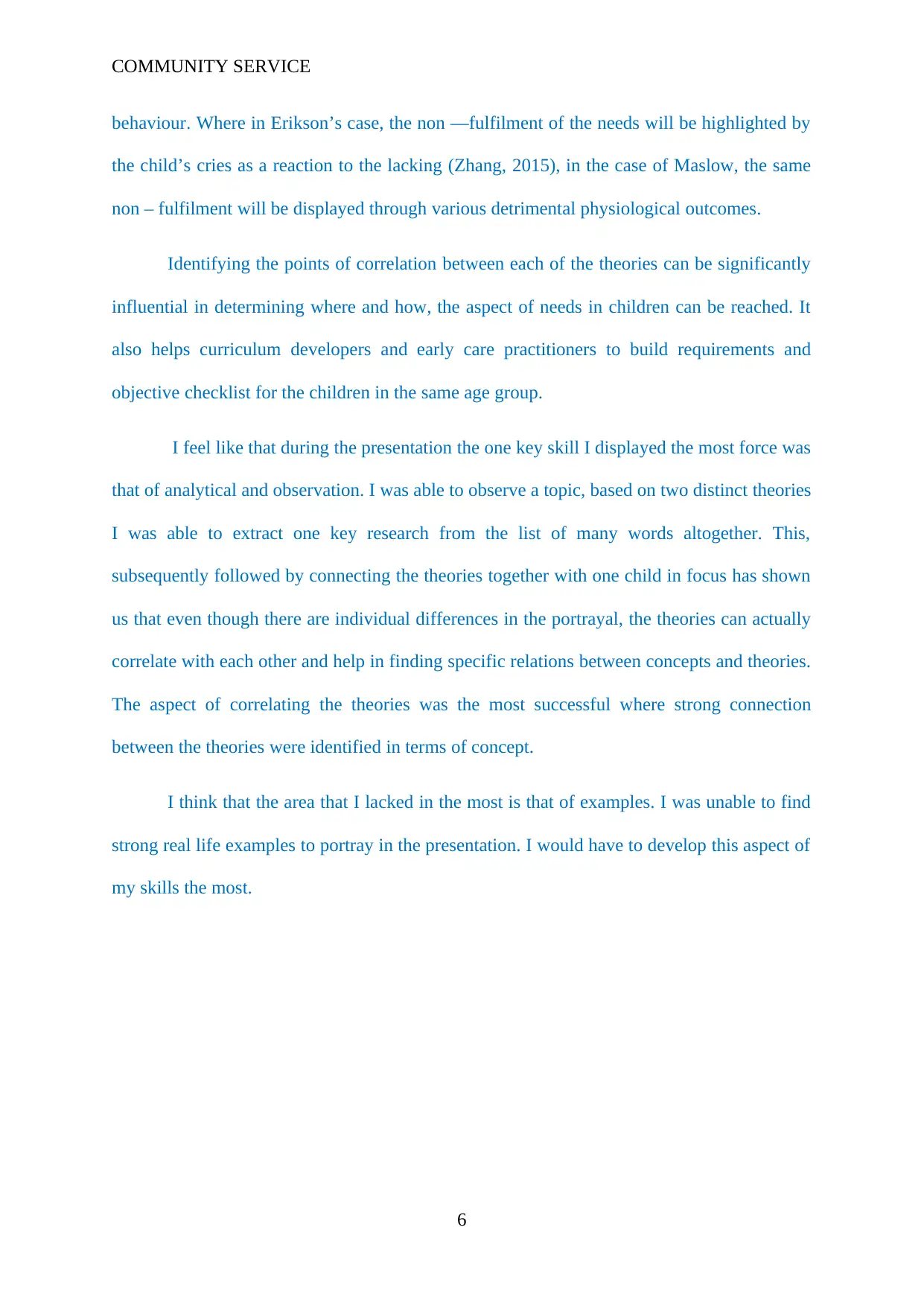
COMMUNITY SERVICE
behaviour. Where in Erikson’s case, the non —fulfilment of the needs will be highlighted by
the child’s cries as a reaction to the lacking (Zhang, 2015), in the case of Maslow, the same
non – fulfilment will be displayed through various detrimental physiological outcomes.
Identifying the points of correlation between each of the theories can be significantly
influential in determining where and how, the aspect of needs in children can be reached. It
also helps curriculum developers and early care practitioners to build requirements and
objective checklist for the children in the same age group.
I feel like that during the presentation the one key skill I displayed the most force was
that of analytical and observation. I was able to observe a topic, based on two distinct theories
I was able to extract one key research from the list of many words altogether. This,
subsequently followed by connecting the theories together with one child in focus has shown
us that even though there are individual differences in the portrayal, the theories can actually
correlate with each other and help in finding specific relations between concepts and theories.
The aspect of correlating the theories was the most successful where strong connection
between the theories were identified in terms of concept.
I think that the area that I lacked in the most is that of examples. I was unable to find
strong real life examples to portray in the presentation. I would have to develop this aspect of
my skills the most.
6
behaviour. Where in Erikson’s case, the non —fulfilment of the needs will be highlighted by
the child’s cries as a reaction to the lacking (Zhang, 2015), in the case of Maslow, the same
non – fulfilment will be displayed through various detrimental physiological outcomes.
Identifying the points of correlation between each of the theories can be significantly
influential in determining where and how, the aspect of needs in children can be reached. It
also helps curriculum developers and early care practitioners to build requirements and
objective checklist for the children in the same age group.
I feel like that during the presentation the one key skill I displayed the most force was
that of analytical and observation. I was able to observe a topic, based on two distinct theories
I was able to extract one key research from the list of many words altogether. This,
subsequently followed by connecting the theories together with one child in focus has shown
us that even though there are individual differences in the portrayal, the theories can actually
correlate with each other and help in finding specific relations between concepts and theories.
The aspect of correlating the theories was the most successful where strong connection
between the theories were identified in terms of concept.
I think that the area that I lacked in the most is that of examples. I was unable to find
strong real life examples to portray in the presentation. I would have to develop this aspect of
my skills the most.
6
Paraphrase This Document
Need a fresh take? Get an instant paraphrase of this document with our AI Paraphraser
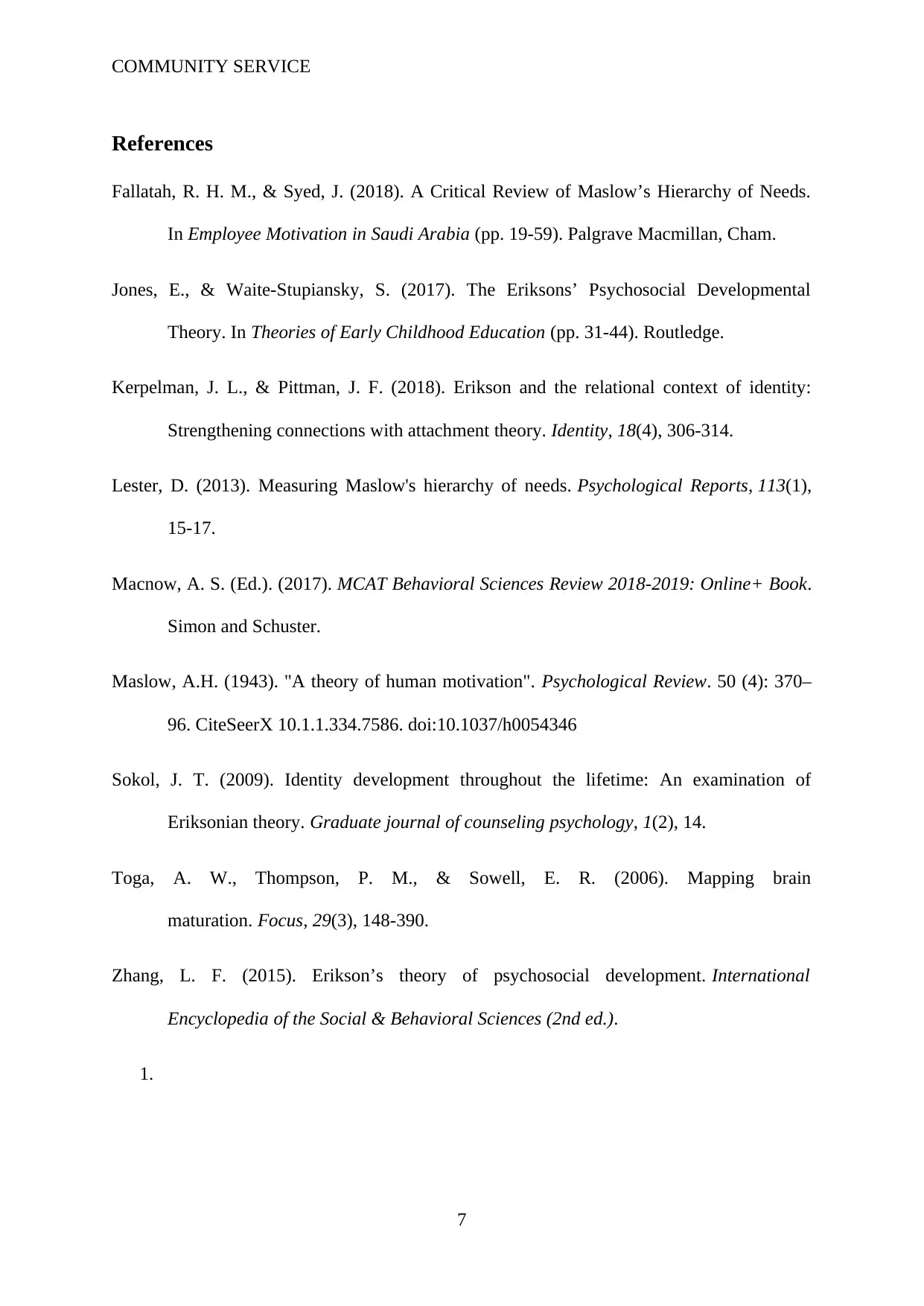
COMMUNITY SERVICE
References
Fallatah, R. H. M., & Syed, J. (2018). A Critical Review of Maslow’s Hierarchy of Needs.
In Employee Motivation in Saudi Arabia (pp. 19-59). Palgrave Macmillan, Cham.
Jones, E., & Waite-Stupiansky, S. (2017). The Eriksons’ Psychosocial Developmental
Theory. In Theories of Early Childhood Education (pp. 31-44). Routledge.
Kerpelman, J. L., & Pittman, J. F. (2018). Erikson and the relational context of identity:
Strengthening connections with attachment theory. Identity, 18(4), 306-314.
Lester, D. (2013). Measuring Maslow's hierarchy of needs. Psychological Reports, 113(1),
15-17.
Macnow, A. S. (Ed.). (2017). MCAT Behavioral Sciences Review 2018-2019: Online+ Book.
Simon and Schuster.
Maslow, A.H. (1943). "A theory of human motivation". Psychological Review. 50 (4): 370–
96. CiteSeerX 10.1.1.334.7586. doi:10.1037/h0054346
Sokol, J. T. (2009). Identity development throughout the lifetime: An examination of
Eriksonian theory. Graduate journal of counseling psychology, 1(2), 14.
Toga, A. W., Thompson, P. M., & Sowell, E. R. (2006). Mapping brain
maturation. Focus, 29(3), 148-390.
Zhang, L. F. (2015). Erikson’s theory of psychosocial development. International
Encyclopedia of the Social & Behavioral Sciences (2nd ed.).
1.
7
References
Fallatah, R. H. M., & Syed, J. (2018). A Critical Review of Maslow’s Hierarchy of Needs.
In Employee Motivation in Saudi Arabia (pp. 19-59). Palgrave Macmillan, Cham.
Jones, E., & Waite-Stupiansky, S. (2017). The Eriksons’ Psychosocial Developmental
Theory. In Theories of Early Childhood Education (pp. 31-44). Routledge.
Kerpelman, J. L., & Pittman, J. F. (2018). Erikson and the relational context of identity:
Strengthening connections with attachment theory. Identity, 18(4), 306-314.
Lester, D. (2013). Measuring Maslow's hierarchy of needs. Psychological Reports, 113(1),
15-17.
Macnow, A. S. (Ed.). (2017). MCAT Behavioral Sciences Review 2018-2019: Online+ Book.
Simon and Schuster.
Maslow, A.H. (1943). "A theory of human motivation". Psychological Review. 50 (4): 370–
96. CiteSeerX 10.1.1.334.7586. doi:10.1037/h0054346
Sokol, J. T. (2009). Identity development throughout the lifetime: An examination of
Eriksonian theory. Graduate journal of counseling psychology, 1(2), 14.
Toga, A. W., Thompson, P. M., & Sowell, E. R. (2006). Mapping brain
maturation. Focus, 29(3), 148-390.
Zhang, L. F. (2015). Erikson’s theory of psychosocial development. International
Encyclopedia of the Social & Behavioral Sciences (2nd ed.).
1.
7
1 out of 8
Related Documents
Your All-in-One AI-Powered Toolkit for Academic Success.
+13062052269
info@desklib.com
Available 24*7 on WhatsApp / Email
![[object Object]](/_next/static/media/star-bottom.7253800d.svg)
Unlock your academic potential
Copyright © 2020–2025 A2Z Services. All Rights Reserved. Developed and managed by ZUCOL.





